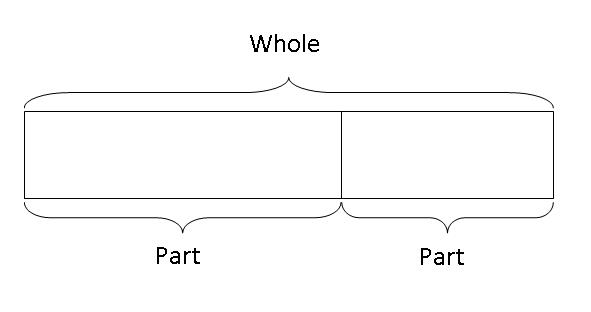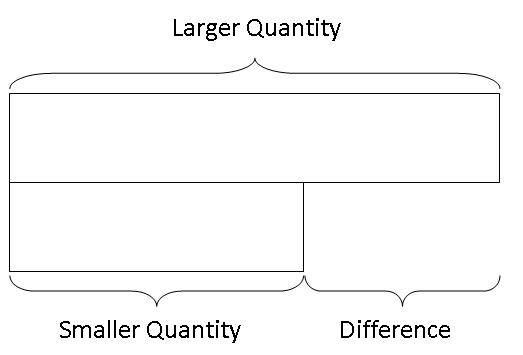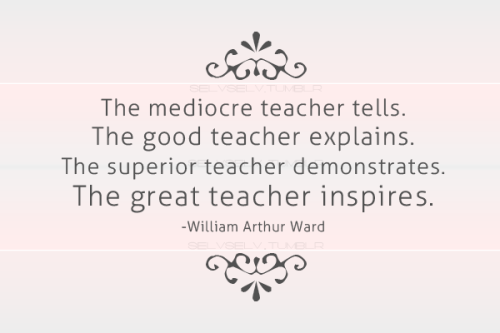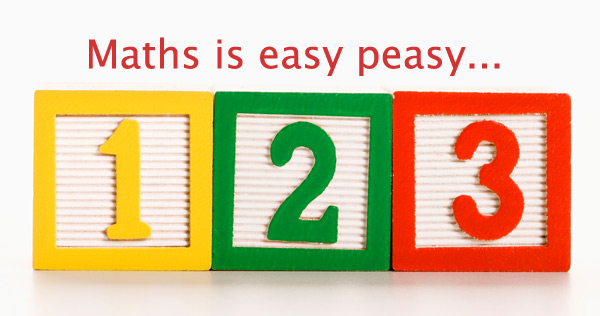"Life is good for only two things, discovering mathematics and teaching mathematics." ~Siméon Poisson
Monday, 8 April 2013
Last but not least...
The quote says it all! Dr. Yeap, thank you for inspiring us to be top notch teachers for all the little children under our care. These six days has taught me the value of enriching children's learning versus accelerating it. I will definitely use more differentiate instructions in class and teach using the CPA approach. Looking forward to the next course on Developing Problem Solving Skills in July. Meanwhile, take care!!
Sunday, 7 April 2013
Reflection on Lesson 6 (6 Apr 2013) - Differentiated Instruction
The learning capacity of all children are different. In a classroom setting, teachers have to deal with children of different learning abilities. Some children are advanced learners, some are average learners while others are slower learners. How can teachers cater to the different needs of the children in the class effectively?
We watched a video on how Dr. Yeap conducted an enrichment activity for a class of Primary 1 children. The children did the number trick activity together. During the process, some children were able to see the link between the two numbers but it was evident that some children were not able to grasp it. As this was an enrichment activity, the children were not expected to understand how it was done if they were not ready yet. But they need to meet the goals of that day's lesson. The children had to practise doing subtraction with renaming and to be able to subtract within 100.
So why are weaker children included in enrichment activities? They are included in these activities so that they can learn from their peers. These children also need to be constantly given the exposure to stimulate their brains. They might not be able to understand fully what is being taught initially, but one day they will be able to get it.
We watched a video on how Dr. Yeap conducted an enrichment activity for a class of Primary 1 children. The children did the number trick activity together. During the process, some children were able to see the link between the two numbers but it was evident that some children were not able to grasp it. As this was an enrichment activity, the children were not expected to understand how it was done if they were not ready yet. But they need to meet the goals of that day's lesson. The children had to practise doing subtraction with renaming and to be able to subtract within 100.
So why are weaker children included in enrichment activities? They are included in these activities so that they can learn from their peers. These children also need to be constantly given the exposure to stimulate their brains. They might not be able to understand fully what is being taught initially, but one day they will be able to get it.
Reflection on Lesson 5 (5 Apr 2013) - Algebraic Thinking
We drew polygons on geoboards in class today. We were only allowed to use 4 dots on the geoboards when drawing our polygons. After drawing the different polygons, we tried to calculate their areas. We used one square as our standard unit of measurement. Calculating the area of some polygons were easy but others were difficult to calculate. There were even some differences in our calculations. Finally, we manged to see a pattern while calculating the area of the polygons. We formulated an equation to help us in our calculation. The equation is Area = x + 1.
Unknowingly, we have learnt algebra tonight. We were provided with opportunities to observe a pattern while calculating the area of the polygons and used algebra to generalise it.
Reflection on Lesson 4 (4 Apr 2013) - Piaget's Model of Intellectual Development
Piaget's Model of Intellectual Development states that during assimilation, we use our current schemes to interpret the external world. In accommodation, we create new schemes or adjust old ones after noticing that our current way of thinking does not capture the environment completely.
This theory applies to all children's learning. In teaching young children mathematics, teachers should not spoon feed them. Instead, teachers should provide young children with lots of experiences to engage in productive struggles. These opportunities help children to develop accommodation.
This theory applies to all children's learning. In teaching young children mathematics, teachers should not spoon feed them. Instead, teachers should provide young children with lots of experiences to engage in productive struggles. These opportunities help children to develop accommodation.
Reflection on Lesson 3 (3 Apr 2013) - Fractions
We began learning about fractions by folding paper. Each of us were given a piece of paper and had to fold it into four equal parts. We explored the different ways of folding the paper to get four equal parts. We shared ideas among ourselves and had much fun.
The activity we did tonight is exactly what all Primary 2 children will do in their first lesson on fractions. I can imagine the fun and excitement the children will have during their learning. The activity is concrete and uses the CPA approach. This approach is being emphasised constantly in class by Dr. Yeap and he always uses it in the lessons that he models in class.
Besides folding paper, we also learnt some facts about fractions.
In addition, I hope that all preschool teachers who are teaching fractions to the children in their class will stop doing it! Fractions are too abstract for young preschoolers to understand and is only taught in Primary 2. Please do not accelerate the children's learning, provide them with enrichment instead.
The activity we did tonight is exactly what all Primary 2 children will do in their first lesson on fractions. I can imagine the fun and excitement the children will have during their learning. The activity is concrete and uses the CPA approach. This approach is being emphasised constantly in class by Dr. Yeap and he always uses it in the lessons that he models in class.
Besides folding paper, we also learnt some facts about fractions.
- Children only learn fraction in Primary 2, they do not need to learn fractions earlier than that.
- Some children struggle with fractions because fractions are written in an unusual way.
- 3/4 should be read as "three fourths" and not "three out of four" or "three over four".
- Never cut an apple into two and claim that they are in halves. We can never be sure that they are in halves unless we weigh it.
In addition, I hope that all preschool teachers who are teaching fractions to the children in their class will stop doing it! Fractions are too abstract for young preschoolers to understand and is only taught in Primary 2. Please do not accelerate the children's learning, provide them with enrichment instead.
Wednesday, 3 April 2013
Reflection on Lesson 2 (2 Apr 2013) - Adding and Subtraction
There are three catergories of problem structures for addition and subtraction situations. They are the part-whole concept, comparison concept and change concept. Drawing models while doing problem sums help children to see the relationship between the three numbers in the sums clearly.
 |
| Part-Whole Concept |
 |
| Comparison Concept |
 |
| Change Concept |
While doing addition and subtraction, there are also different properties to guide us. The commutative property of addition states that we can change the order of the addends of an addition sum and it does not change the answer. The associative property of addition shares that when adding three or more numbers, it does not matter which pair of addens is added first, the answer is still the same. Using zero are good methods of helping children understand zero as an identity element in addition and subtraction. This concept of zero property will help children become more flexible in how they combine numbers.
Although the preschoolers I teach need not learn how to solve problem sums formally, I have an important role to play in their learning of mathemtics. My role now is to help the children develop their number sense and let them see the relationships between numnbers 1 through 10.
Reflection on Lesson 1 (1 Apr 2013) - Problem Solving
Solving problems is fun! We solved two problems in class today and the process was very enjoyable.
We tried solving the name problem and discovered that there were more than one way of finding the solution. During the process, Dr. Yeap did not tell us how to solve the problem. Instead, he used the different strategies of carrying instructions to guide us. He modelled, scaffolded, provided and explained. We also talked among ourselves while trying to figure out the way to solve the problem. This experience was supported by Vygotsky's theory that learning occurs in a social setting. Dr. Yeap was also heard saying "I wonder why? " I later learnt that it was intentional. When a teacher asks this question, he is scaffolding the students' learning. He is also indirectly getting children to think for new ideas and modelling the wondering mind.
This simple problem solving exercise equips me with the skills that I need to use when conducting mathematics activities with children in my class. With this hands-on and engaging method I learnt tonight, I am sure the children in my class will find solving problems not intimidating and a breeze!!
We tried solving the name problem and discovered that there were more than one way of finding the solution. During the process, Dr. Yeap did not tell us how to solve the problem. Instead, he used the different strategies of carrying instructions to guide us. He modelled, scaffolded, provided and explained. We also talked among ourselves while trying to figure out the way to solve the problem. This experience was supported by Vygotsky's theory that learning occurs in a social setting. Dr. Yeap was also heard saying "I wonder why? " I later learnt that it was intentional. When a teacher asks this question, he is scaffolding the students' learning. He is also indirectly getting children to think for new ideas and modelling the wondering mind.
This simple problem solving exercise equips me with the skills that I need to use when conducting mathematics activities with children in my class. With this hands-on and engaging method I learnt tonight, I am sure the children in my class will find solving problems not intimidating and a breeze!!
Friday, 29 March 2013
Pre-course Reading (Chpater 1 & Chapter 2)
Chapter 1
Learning mathematics can be made fun and meaningful for young children if teachers set the stage right. To assist us, we require a set of guideline to give us directions on what the children need to achieve at the different levels. In this chapter, the authors highlighted the Principles and Standards for School Mathematics. These directions are important as they guide us when we plan teaching strategies to help young children acquire the necessary skills in mathematics. However, I feel that all these guidelines and direction are merely white elephant if teachers are not able to effectively impart their knowledge of this subject to young children.
Successful mathematics teachers need to have knowledge of mathematics, persistence, positive attitude, readiness for change and reflection disposition as shared by the authors. I agree with the authors and I am determined to improve myself to be a better mathematics teacher. I am confident that this shift will make a great difference to the way young children in my class learn mathematics. Hopefully, more children in my class will tackle mathematics with confidence and say "I love math!"
Chapter 2
Children need to be involved in all their learning. Learning mathematics is no different from learning other subjects. When planning teaching strategies for young children, teachers can use the various theories by Piaget and Vygotsky to guide them. Their understanding of the theories will help them set objectives that are realistic and developmentally appropriate for the children.
I firmly believe that all children's learning should be within their zone of proximal development. In this chapter, the authors explained that children need to be engaged in "productive struggles" during the process of learning mathematics. Such struggles keep them engaged and eventually allow them to solve problems. Although teachers should not spoon feed the children with solutions, I feel that we need to be observant and know when to step in to help children who have been struggling too long with a particular problem. In my view, when children are constantly challenged with mathematics problems that they cannot solve no matter how hard they try, they are not learning within their zone of proximal development. When this happens too often, their confidence level will hit rock bottom. It is then necessary for teachers to reflect on their teaching strategies and make changes.
Children can be successful learners of mathematics if teachers are able to help them make connection between the blue dots (existing ideas) and the red dots (red dots). These connection will ultimately bring the children's understanding closer to the relational end of the continuum. This is a goal that all successful mathematics teachers hope their children can achieve!!
Learning mathematics can be made fun and meaningful for young children if teachers set the stage right. To assist us, we require a set of guideline to give us directions on what the children need to achieve at the different levels. In this chapter, the authors highlighted the Principles and Standards for School Mathematics. These directions are important as they guide us when we plan teaching strategies to help young children acquire the necessary skills in mathematics. However, I feel that all these guidelines and direction are merely white elephant if teachers are not able to effectively impart their knowledge of this subject to young children.
Successful mathematics teachers need to have knowledge of mathematics, persistence, positive attitude, readiness for change and reflection disposition as shared by the authors. I agree with the authors and I am determined to improve myself to be a better mathematics teacher. I am confident that this shift will make a great difference to the way young children in my class learn mathematics. Hopefully, more children in my class will tackle mathematics with confidence and say "I love math!"
Chapter 2
Children need to be involved in all their learning. Learning mathematics is no different from learning other subjects. When planning teaching strategies for young children, teachers can use the various theories by Piaget and Vygotsky to guide them. Their understanding of the theories will help them set objectives that are realistic and developmentally appropriate for the children.
I firmly believe that all children's learning should be within their zone of proximal development. In this chapter, the authors explained that children need to be engaged in "productive struggles" during the process of learning mathematics. Such struggles keep them engaged and eventually allow them to solve problems. Although teachers should not spoon feed the children with solutions, I feel that we need to be observant and know when to step in to help children who have been struggling too long with a particular problem. In my view, when children are constantly challenged with mathematics problems that they cannot solve no matter how hard they try, they are not learning within their zone of proximal development. When this happens too often, their confidence level will hit rock bottom. It is then necessary for teachers to reflect on their teaching strategies and make changes.
Children can be successful learners of mathematics if teachers are able to help them make connection between the blue dots (existing ideas) and the red dots (red dots). These connection will ultimately bring the children's understanding closer to the relational end of the continuum. This is a goal that all successful mathematics teachers hope their children can achieve!!
Subscribe to:
Comments (Atom)







